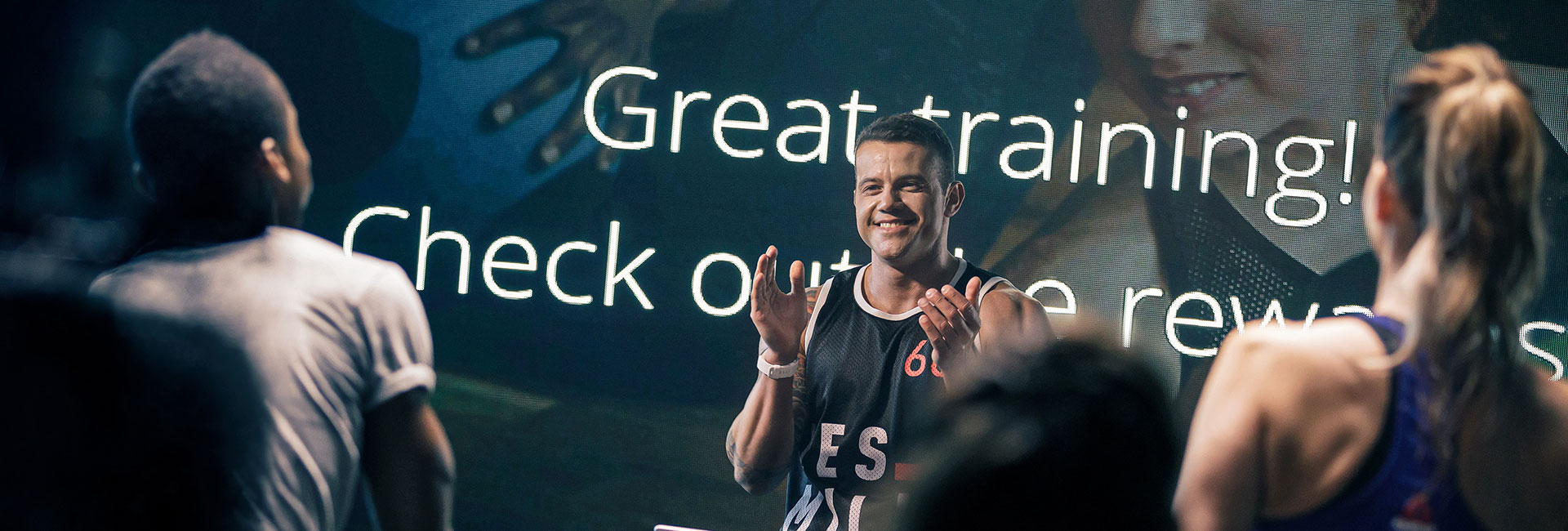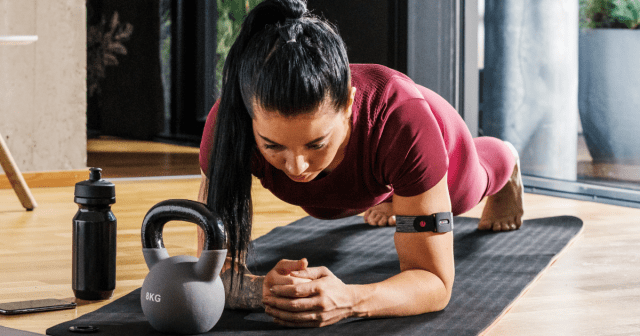Wondering how to choose a group fitness class? Sometimes it can be quite confusing.
“The workout is for anyone looking to get lean, toned, and fit – fast. Using light to moderate weights with lots of repetition, it gives you a total body workout,” reads the description of a popular group exercise class format.
“A high-intensity cardio workout designed to build strength and stamina. The high-energy class combines sports-inspired athletic aerobic movements with strength and stabilization exercises,” states that of another.
The goals of the classes seem simple enough: the first one is strength training, aimed at making you a lean, mean power machine, whereas the latter sounds like a punch-in-the-gut, leave-you-gasping-for-air type of cardio session.
But is comparing the two like comparing apples to oranges? And how exactly should you go about choosing the right one for you? Well, read on, as this guide is here to help you work out how to choose a group fitness class.
The difficulty of choosing a group fitness class
The fact that BODYPUMP uses smaller weights and (much) more repetitions than the more traditional heavy-weights-short-sets strength training also means that your heart rate stays nice and awake throughout the class.
Even though there are distinct differences between BODYPUMP™ and BODYATTACK™ classes described above, these LES MILLS™ formats are not quite as different as it might seem at first glance.
If you want to make your BODYPUMP session an even tougher cardio workout, the recipe is simple: Add more weights.
Three of the class’s ten tracks are specifically aimed at large muscle groups. Squats, back work and lunges are referred to as heart rate peak tracks by those in the know, and during the three, it’s hard not to get breathless.
BODYATTACK, on the other hand, is primarily a cardio class, using your own bodyweight. Yet, it can feel like a serious challenge for the poor muscles, too.
By choosing the low-intensity (read: no jumps) options offered in BODYATTACK means getting a more manageable cardio interval workout. Yet, the class provides a significant amount of strength training – mainly in the form of chest and tricep push-ups, squats, lunges, and every kind of abdominal crunch imaginable.
What really is the difference between a 45-minute class for beginners and a 50-minute advanced class?
Things get even more complicated when you want to get your cardio on an indoor bicycle, but have to manage through the jungle of different kinds of class descriptions.
If the line between each one is this blurred, then how to choose a group fitness class? Where to head and what to do for the desired workout outcomes?
Fret not: the answer is simpler – and closer – than you think.
how to choose a group fitness class for you
If you want to play it smart and reach your personal goals in group exercise, there are two main things you can do:
STEP 1
Use the class description as your general guideline. If you’re primarily looking to tone and build your muscles, head for a class marketed as a strength training format.
Even though, say, a BODYBALANCE™ class with its static holds and challenging poses might effectively build muscle endurance, its primary focus is on mobility, whereas a class like BODYPUMP concentrates its efforts directly on strength training.
Likewise, it’s easier to get a load of cardio work in a BODYATTACK class than it is in BODYBALANCE, even though a series of sun salutations in the latter is guaranteed to get your heart pumping.
STEP 2
The second way to ensure that you reach your fitness goals is to track the effects of workouts and see what different reactions they have on your body. This is where monitoring your heart rate comes to play.
As a rule of thumb, the group exercise classes labeled as primarily ‘cardio’ are intended to improve your cardiovascular system – and burn lots of calories while doing so. The classes in which you can expect to get, and stay, breathless are ones where you are constantly on the move.
The lighter end of the spectrum includes classes like slow tempo dance classes and gets increasingly more challenging with a faster beat (think Zumba®), or the addition of a step platform or hops and jumps. At the peak of cardio are classes like indoor cycling and treadmill group exercise runs.
Even though observing your heart rate in strength training isn’t futile, it isn’t the most important thing to pay attention to when building muscle strength. The zone in which your heart rate is while doing bicep curls is not as important as the weight you do the curls with if your goal is to increase the size and strength of the bicep.
Working out together, but solo
In an ideal world, all of us group exercise junkies could take the exact class we want to at the exact date and time we want to – and preferably taught by our favorite instructor, too. However, oftentimes our own schedules do not match those of the gym, and we have to compromise.
That’s when you have to remind yourself that your individual training goals supersede those of any class descriptions.
In a class where everyone’s beats are displayed on a screen in front of the room, it can take a lot of courage to hold your head high and do your own thing.
There are some guidelines that help us make the most out of every single workout. Viewing them from a heart rate point of view is easiest with the help of heart rate zones, which are what Polar monitors use to track our beats and to give us an idea of how our bodies are doing and what features and abilities in them we are improving.
Group fitness classes by heart rate zone categories
A rough categorization puts group fitness classes in five different categories, following Polar heart rate zones.
Heart rate zone 1
This is a very light cardio workout. Spending time here feels like a walk in the park: effortless and enjoyable. It’s the easiest kind of activity and lifts your heart rate to about 50 to 60% of its maximum.
Typical zone 1 group exercise workouts are the warm-up and cool-down portions of classes, as well as mind-body classes like stretching, Pilates, or gentle yoga.
Heart rate zone 2
This is slightly harder and can be described as light effort. Although your heart rate is not significantly higher – about 60 to 70% of your max – a big part of your cardio work should happen in this zone. This is also where your general base fitness efficiently develops.
Zone 2 is where many dance classes, as well as strength and toning classes like BARRE and BODYPUMP, find themselves. Even an indoor cycling class can stay in zone 2, as long as the resistance and RPM’s stay moderate.
On the other hand, vigorous yoga practice performed in a hot room, which automatically picks up your beats, can also put your average heart rate in zone 2.
Heart rate zone 3
Here’s where your breathing begins to sound like you’re working out. At 70 to 80% of your max heart rate, the workout feels moderate and training enhances your efficiency and general training pace.
A bulk of cardio group exercise like step classes, Zumba-type intense dance classes, as well as most indoor cycling, end up in this zone. In, for example, high-intensity interval (HIIT), treadmill classes, or BODYATTACK, zone 3 is often where you attempt to recover.
Heart rate zone 4
This is where you get busy! You are pushing your heart at 80 to 90% of its maximum beat capacity, sustaining the effort for no longer than 10 minutes at a time. Very few of us end up with zone 4 as the average for our entire group exercise class – and that’s not its purpose either. Indoor cycling is great at picking the effort level up to zone 4 and sustaining it for a little while, but eventually, you’ll need to pull back. Expect to spend time in this zone in classes like BODYATTACK and HIIT, too.
Heart rate zone 5
This zone needs no introductions. This is where you should give it your all – 90 to 100%. It’s the last minute of the last climb in an indoor cycling session, the final plyometric push of a cardio class, and the high-knee sprint that tops off the high-intensity interval.
How to use heart rate in group fitness classes
The beauty of knowing where your heart rate is at is the ability to do something about it if the numbers are not what you hoped they would be. Real-time feedback also shows you immediately how your body reacts to added intensity.
What if you’re in an indoor cycling class and can’t seem to leave zone 2? Pick up your pace and add resistance!
What to do when a step class has you stuck in zone 3? Add efficient upper bodywork by pumping your arms, and lift your knees higher!
And for those days when you really want to see what you are made of, take a look at your beats and challenge yourself to hit a high note and visit zone 5 by pushing harder, faster, and higher.
For those of us just wanting to enjoy – the often literal – heat of the moment and not look at our devices while working out, you have Polar Flow to go to after your workout.
Refueling with your favorite recovery snack on your couch, bathing in the post-workout endorphin high, Polar Flow draws a chart and shows you exactly what you achieved with your workout and how it improved your performance for your next class – the one in which you’ll do even better, perhaps go a little harder, and take another leap towards your personal fitness goals.
If you liked this post, don’t forget to share so that others can find it, too.
Or give it a thumbs up!
I like this article
Please note that the information provided in the Polar Blog articles cannot replace individual advice from health professionals. Please consult your physician before starting a new fitness program.





